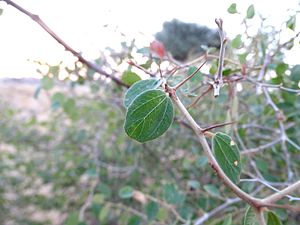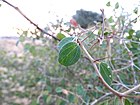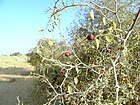Note: This is a project under development. The articles on this wiki are just being initiated and broadly incomplete. You can Help creating new pages.
Difference between revisions of "Ziziphus nummularia - Balakapriya"
(→References) |
(→References) |
||
| (27 intermediate revisions by 2 users not shown) | |||
| Line 4: | Line 4: | ||
==Uses== | ==Uses== | ||
| − | {{Uses| | + | {{Uses|Scabies}}, {{Uses|Skin diseases}}, {{Uses|Influenza}}, {{Uses|Cold}}, {{Uses|Dysentery}}, {{Uses|Diarrhoea}}, {{Uses|Colic}}, {{Uses|Ulcers}}, {{Uses|Fever}}. |
==Parts Used== | ==Parts Used== | ||
| − | {{Parts Used| | + | {{Parts Used|Roots}}, {{Parts Used|Barks}}, {{Parts Used|Leaves}}. |
==Chemical Composition== | ==Chemical Composition== | ||
| − | + | A 13-membered -formylcyclopeptide alkaloid, nummularine-T, has been isolated from the bark of Ziziphus nummularia. | |
| − | |||
==Common names== | ==Common names== | ||
| − | {{Common names|kn= | + | {{Common names|kn=|ml=|sa=Aja-priya, Balakapriya, Bhu-kartaka|ta=|te=|hi=Jharberi, jharber|en=}} |
| + | |||
| + | ==Properties== | ||
| + | Reference: Dravya - Substance, Rasa - Taste, Guna - Qualities, Veerya - Potency, Vipaka - Post-digesion effect, Karma - Pharmacological activity, Prabhava - Therepeutics. | ||
| + | ===Dravya=== | ||
| + | |||
| + | ===Rasa=== | ||
| + | |||
| + | ===Guna=== | ||
| + | |||
| + | ===Veerya=== | ||
| + | |||
| + | ===Vipaka=== | ||
| + | |||
| + | ===Karma=== | ||
| + | |||
| + | ===Prabhava=== | ||
==Habit== | ==Habit== | ||
| Line 21: | Line 36: | ||
==Identification== | ==Identification== | ||
===Leaf=== | ===Leaf=== | ||
| − | {{Leaf| | + | {{Leaf|Ovate|Elliptic|Oblique or rounded at base, serrate at margin, acute or obtuse at apex, 1-2.5 x 0.5-1.8 cm, glabrous or tomentose above, tomentose to white-wooly beneath, 3-nerved at base}}<ref name="Leaf"/> |
===Flower=== | ===Flower=== | ||
| − | {{Flower| | + | {{Flower|Unisexual|Flowers 4-5 mm across|5 stamens|Stamens 0.8-1.2 mm long|Inflorescences axillary 10-20 flowered cymes, Flowering and Fruiting Time : September}} |
| − | |||
| − | |||
| − | |||
| − | |||
===Fruit=== | ===Fruit=== | ||
| − | {{Fruit| | + | {{Fruit|Short legume|Seeds 1 or 2 compressed, black|Glabrous|12-20 seeds, Disc faintly 10-lobed. Ovary 2-loculed, Flowering and Fruiting Time : September}} |
===Other features=== | ===Other features=== | ||
==List of Ayurvedic medicine in which the herb is used== | ==List of Ayurvedic medicine in which the herb is used== | ||
| − | |||
==Where to get the saplings== | ==Where to get the saplings== | ||
| Line 46: | Line 56: | ||
==Commonly seen growing in areas== | ==Commonly seen growing in areas== | ||
| − | {{Commonly seen| | + | {{Commonly seen|Dry regions of India}}, {{Commonly seen|Sea coast}}, {{Commonly seen|Dry zone in Sri Lanka}}. |
| − | |||
==Photo Gallery== | ==Photo Gallery== | ||
<gallery class="left" caption="" widths="140px" heights="140px"> | <gallery class="left" caption="" widths="140px" heights="140px"> | ||
| − | File: | + | File:Ziziphus nummularia1.jpg |
| − | File: | + | File:Ziziphus nummularia2.jpg |
| − | + | File:Ziziphus nummularia3.jpg | |
| − | + | File:Ziziphus nummularia4.jpg | |
</gallery> | </gallery> | ||
| Line 60: | Line 69: | ||
<references> | <references> | ||
| − | + | ||
| − | <ref name="Leaf">[https://indiabiodiversity.org/species/show/231525 | + | <ref name="Leaf">[https://indiabiodiversity.org/species/show/231525 Morphology]</ref> |
| − | <ref name="How to plant/cultivate">[https://www.prota4u.org/database/protav8.asp?g=pe&p=Senna+auriculata+(L.)+Roxb. | + | <ref name="How to plant/cultivate">[https://www.prota4u.org/database/protav8.asp?g=pe&p=Senna+auriculata+(L.)+Roxb. Planting]</ref> |
</references> | </references> | ||
==External Links== | ==External Links== | ||
| − | + | * [http://www.flowersofindia.net/catalog/slides/Jhar%20Beri.html Ziziphus nummularia on flowers of india] | |
| − | + | * [http://www.efloras.org/florataxon.aspx?flora_id=5&taxon_id=250075386 Ziziphus nummularia on efloras.org] | |
| + | * [http://www.worldagroforestry.org/treedb/AFTPDFS/Zizyphus_nummularia.PDF Ziziphus nummularia on world grow forestry] | ||
| + | * [http://eol.org/pages/483648/overview Ziziphus nummularia on encyclopedea of life] | ||
[[Category:Herbs]] | [[Category:Herbs]] | ||
Latest revision as of 10:54, 10 September 2020
Balakapriya or Ziziphus nummularia is a species of Ziziphus native to the Thar Desert of western India and southeastern Pakistan and south Iran. Common names are Mulluhannu, Bhu-kartaka, Zariab etc.
Contents
- 1 Uses
- 2 Parts Used
- 3 Chemical Composition
- 4 Common names
- 5 Properties
- 6 Habit
- 7 Identification
- 8 List of Ayurvedic medicine in which the herb is used
- 9 Where to get the saplings
- 10 Mode of Propagation
- 11 How to plant/cultivate
- 12 Commonly seen growing in areas
- 13 Photo Gallery
- 14 References
- 15 External Links
Uses
Scabies, Skin diseases, Influenza, Cold, Dysentery, Diarrhoea, Colic, Ulcers, Fever.
Parts Used
Chemical Composition
A 13-membered -formylcyclopeptide alkaloid, nummularine-T, has been isolated from the bark of Ziziphus nummularia.
Common names
| Language | Common name |
|---|---|
| Kannada | |
| Hindi | Jharberi, jharber |
| Malayalam | |
| Tamil | |
| Telugu | |
| Marathi | NA |
| Gujarathi | NA |
| Punjabi | NA |
| Kashmiri | NA |
| Sanskrit | Aja-priya, Balakapriya, Bhu-kartaka |
| English |
Properties
Reference: Dravya - Substance, Rasa - Taste, Guna - Qualities, Veerya - Potency, Vipaka - Post-digesion effect, Karma - Pharmacological activity, Prabhava - Therepeutics.
Dravya
Rasa
Guna
Veerya
Vipaka
Karma
Prabhava
Habit
Identification
Leaf
| Kind | Shape | Feature |
|---|---|---|
| Ovate | Elliptic | Oblique or rounded at base, serrate at margin, acute or obtuse at apex, 1-2.5 x 0.5-1.8 cm, glabrous or tomentose above, tomentose to white-wooly beneath, 3-nerved at base |
Flower
| Type | Size | Color and composition | Stamen | More information |
|---|---|---|---|---|
| Unisexual | Flowers 4-5 mm across | 5 stamens | Stamens 0.8-1.2 mm long | Inflorescences axillary 10-20 flowered cymes, Flowering and Fruiting Time : September |
Fruit
| Type | Size | Mass | Appearance | Seeds | More information |
|---|---|---|---|---|---|
| Short legume | Seeds 1 or 2 compressed, black | Glabrous | 12-20 seeds, Disc faintly 10-lobed. Ovary 2-loculed, Flowering and Fruiting Time : September | {{{5}}} | {{{6}}} |
Other features
List of Ayurvedic medicine in which the herb is used
Where to get the saplings
Mode of Propagation
How to plant/cultivate
Plants reach about 3 m height with 3.5 cm stem diameter in 2 years, in 4 years about 5 m height and 7 cm stem diameter. Flowering and fruiting is almost throughout the year, but in India there are usually two main flowering periods, one in the early monsoon and another in the late monsoon.[2]
Commonly seen growing in areas
Dry regions of India, Sea coast, Dry zone in Sri Lanka.
Photo Gallery
References
External Links
- Ayurvedic Herbs known to be helpful to treat Scabies
- Ayurvedic Herbs known to be helpful to treat Skin diseases
- Ayurvedic Herbs known to be helpful to treat Influenza
- Ayurvedic Herbs known to be helpful to treat Cold
- Ayurvedic Herbs known to be helpful to treat Dysentery
- Ayurvedic Herbs known to be helpful to treat Diarrhoea
- Ayurvedic Herbs known to be helpful to treat Colic
- Ayurvedic Herbs known to be helpful to treat Ulcers
- Ayurvedic Herbs known to be helpful to treat Fever
- Herbs with Roots used in medicine
- Herbs with Barks used in medicine
- Herbs with Leaves used in medicine
- Herbs with common name in Hindi
- Herbs with common name in Sanskrit
- Habit - branched shrub
- Index of Plants which can be propagated by Seeds
- Index of Plants which can be propagated by Cuttings
- Herbs that are commonly seen in the region of Dry regions of India
- Herbs that are commonly seen in the region of Sea coast
- Herbs that are commonly seen in the region of Dry zone in Sri Lanka
- Herbs




